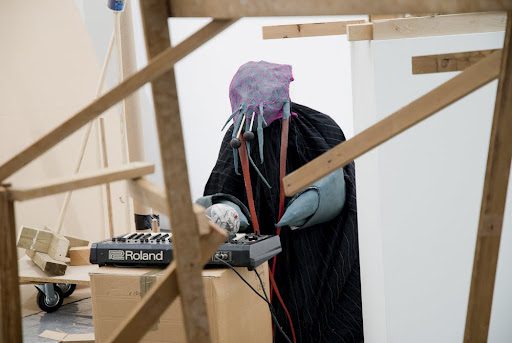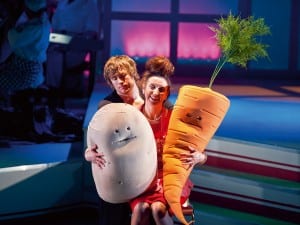Review by Charles Danby
The Jerwood Encounters series was launched in 2008 to investigate the margins of the primary fields of the Jerwood visual arts programme, of painting, sculpture, drawing and photography, and as such it has most readily orientated itself around performance, media and event. SHOW is the latest of this series, the fourth devised and curated by in-house curator Sarah Williams. In line with her previous outputs, Locate (2010), Laboratory (2009), An Experiment in Collaboration (2008), SHOW places new work, process, documentation, and durational activity, centrally to an investigation of what an exhibition and curatorial framework is and can be.
Jerwood curator Sarah Williams has throughout these projects put forward progressive proposals as to what can constitute documentation and archive within the work and activity of the exhibiting artists she has worked with. In Laboratory (2009) an online platform was used to build a working archive through the duration of the project. This placed contributions from commissioned writers alongside conversations from online forums, mixed press cuttings with emails, and offset official photographic documentation with images posted externally. Unedited this material was printed to create a catalogue. In SHOW the commissions of artists Edwina Ashton, Jack Strange and Bedwyr Williams have been supported by a stand-alone website and two essays, one written by Catherine Wood (Tate Curator of Performance / Contemporary Art), and the other by SHOW’s curator.
Williams’ text makes a practical dissection of the artists involved, unpicking (in its introduction) the context of “performance” as considered within SHOW. Performance here is noted to be central, but not exclusive, to the practices of the selected artists. This trajectory of contemporary performance as a partial component of a wider more discursive output also underpins Catherine Wood’s text.
Wood notes the central placement of performance within the framework of contemporary mixed media practices, sighting one emerging aspect of this tendency as being an alternative exposure of practical input, “Performance offers a means of dramatizing the process of artistic creation itself: the ‘work’ of art as the ‘work of art’…” This is a process that Wood further suggests has become a valuable mechanism by which artists choose to connect (socially and analytically) to the (recurrent) question of “how art makes sense in our world today”. Wood also draws attention to the altered territory (engagement) of viewing that contemporary practices demand, a revision within which, she suggests, performance (as live moment) emerges naturally as a connecting tissue, “For many artists working today the choreography of positions between artist, artwork and audience is what constitutes the meaning of the work, and what draws attention to the particular nature of art experience.”
The opening night of SHOW saw the deployment of performance within the work of each of the three commissioned artists. It was however only Bedwyr Williams that took directly to the stage as both artist and performer. The work of both Edwina Ashton and Jack Strange was enacted remotely by instructed performers, who curiously in both cases, and through very different circumstance, where like the artists, ‘unseen’. Ashton’s performers (lobsters) through the heavy cladding of their all-over costumes, and Strange’s performers through their selective revealing of body parts. In the first room of the Jerwood Gallery very little was visible aside from the mass of people attending. Artworks are often obscured and barely visible at openings and so the actual emptiness of the gallery did not appear to raise issue and in many ways was simply conducive to norms. On the main wall however there were two small circular holes around 6 to 8 feet apart and a foot and a half or so from the floor. These ‘glory’ holes were vicariously animated by legs jiggling as both mute (and possibly substitutive) gesture, and as certification of the fact that they were real legs and not inert fabricated appropriations. Their quivering aliveness questioned the stasis of the object, and specifically the (often partial) object mannequins of artists such as, Robert Gober, Maurizio Cattelan, and Jemima Brown, but here the synthesised dismemberment of a human body (a leg) remained unquestionably attached to a living entity. As such the work took on a dynamic of physical constraint and limitation rather than a double-take manifested through approximate material concern. Through this shift Strange tapped the work (latently) into a host of art and performance tropes, but while many of these were implicitly transgressive, the work hovered and resonated with little more than polite and quiet removal.
In the furthest gallery Edwina Ashton presented Peaceful serious creatures (lobster arranging) (2011), a cluttered room of collected materials familiar to the detritus of studio or gallery. These ranged from rough breaks of plasterboard, odd ends of 2×1 wood, and packing blankets, to less familiar items such as egg cartons and an electric keyboard. The contrivance of stage-set was apparent and predictable, but what was interesting and curious was the compelling nature of the orchestrated intervention within the space by a series of performers dressed as lobsters. At undisclosed intervals a solitary ‘human’ lobster inhabited the space and went silently about its business – whatever that might have been. Moving within the mass of (generally uninspiring) materials the lobster would pick things up, put things down, organise, assemble, and disassemble. The differences between these actions, ordinarily readily discernible, became difficult to assess under the circumstance of the displacement of the performer; their invisibility (under a heavily draped costume), their silence, and the restriction imposed by the costume on their movement. The action (communication) of the lobster was reduced to the handling of materials, and this occurred through large awkward claws that slowed and eliminated any familiar or habitual movement. Ashton’s deployment of the performer as lobster is tied to a characteristic of the animal whereby it constantly rearranges its living space. The connection to (or commentary on) human (or specifically artistic) behavioural tendencies was not intrinsically interesting in itself. What was interesting was the curious unlocking of materials through intensive introspection (on the part of the performer) that emerged through the slowness and awkwardness of the active moments of performance.
Welsh artist Bedwyr Williams had likewise constructed a stage-set, this time not as a playground, but rather to serve one specific function, a single short moment of performance presented at the opening of the exhibition to mark the launch of a book, a compendium of almost all of his previous performances to date. A central platform was filled with piles of Williams’ book, usefully titled Bedwyr I’m sorry I missed your performance, a line that has no doubt resonated at regular interval in shops and pubs, on Williams’ mobile phone, and in the sanctum of his online inbox throughout the fifteen or so years of his performances.
To either side of the stage were large projected images. On the left screen was a heavy-tread (tractor) tyre, set on an empty background, eternally forward rolling, and emblazoned by the flames of a fast food advert. To the right was a stationary image of the artist, flat cap and jacket, with this back turned to the camera, gazing towards a distant pastoral void. In the top left corner a moving graphic depicted what appeared to be mechanically jointed legs. To the side of the platform was a pair of shoes, while on stage alongside the books was a medical kneeling (back) chair, a microphone, and an exercise ball.
The performance, under the title of Urban Hick, after initial introductions, “…Hi Bedwir, Hi Bedw-uh…This is how posh people mispronounce my name…” a short musing on the role of performance, “…a performance once it’s done has a stink to it… To use it again you need to turn it inside out…” and the collective imagining of each listener as a mole (bad eyesight no doubt being the key), began with a quick tour of London. The audience was taken from the “…tang of piss with the burning glove waft of crispy duck…” on Charing Cross Road to the East End where “Drag Queens are the live art equivalent of a ready meal. Ultimately unsatisfying.” Leaving London, still as incantations of burrowing moles, Williams described performing for a client at a private dinner party. In line with the twofold ‘mirrored’ nature of the exhibition’s title, SHOW, this was likewise contingent to the recurrent paradox of performance – that of who is performing, and to whom. Having arrived at the house Williams’ story continued, “They are all acting weird. Pretending to be disinterested. Who is going to be doing this performance anyway?”
Williams has an exacting eye for observation, his storytelling was as sharp tongued, potty-mouthed, and impeccably delivered as anyone familiar with this work would have expected. Less here, but lines deployed by Williams are often delivered and left simply to hang in isolation. Such a notion of unsightedness and apparition seemed to reach across the works, conjuring a partial retrieval of things already shown.
SHOW continues at JVA, Jerwood Space until 21 April. For more information please visit www.jerwoodvisualarts.org. To access Aesthetica’s feature on the Jerwood Contemporary Makers please click here.
Image: Edwina Ashton, Peaceful serious creatures (lobster arranging), performance, duration: three hours intermittently, 2011





